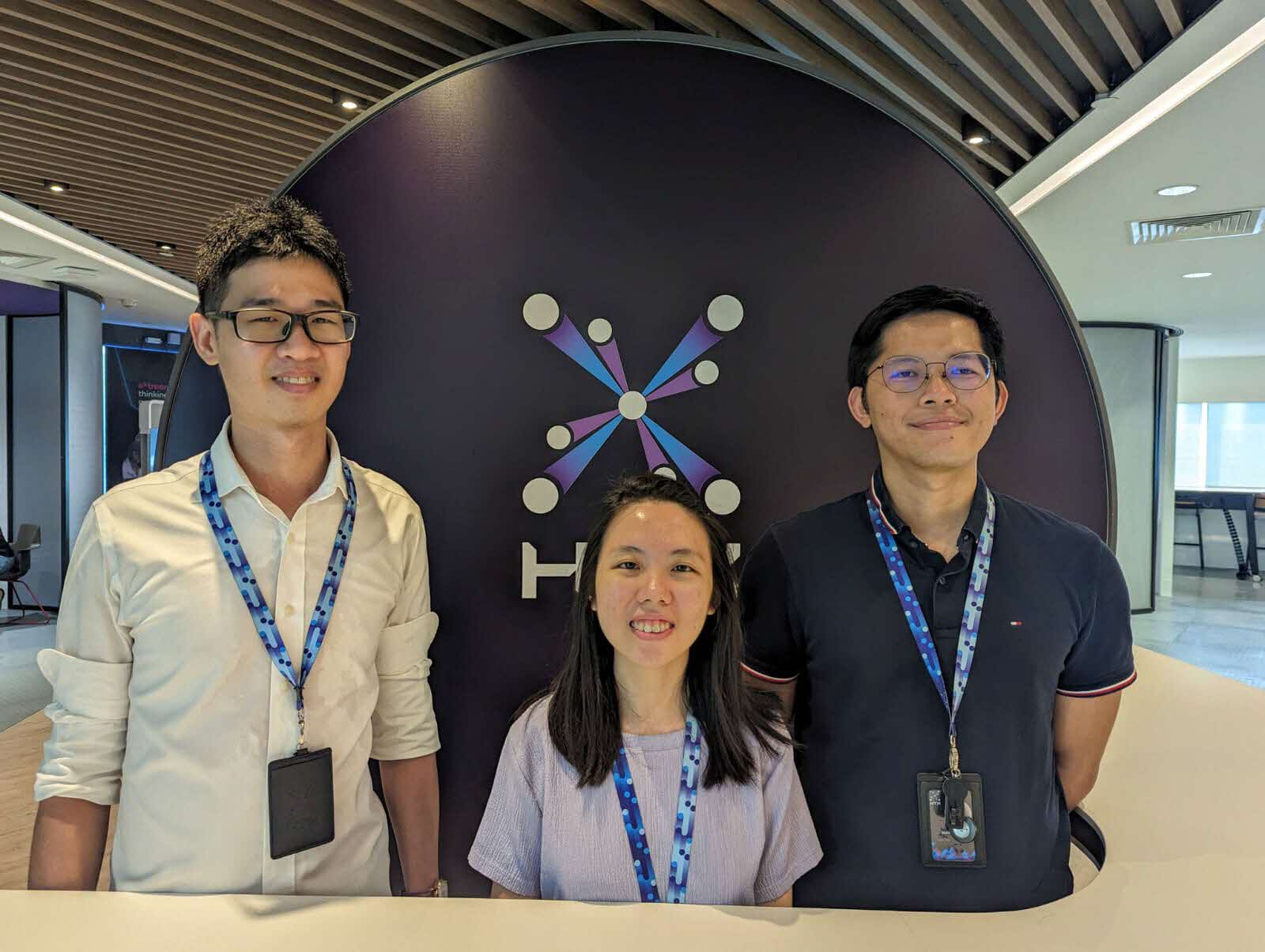 Ong Pang Wei (left), Tan Wei Lin (middle), and Martyn Wong (right) (Photo: HTX)
Ong Pang Wei (left), Tan Wei Lin (middle), and Martyn Wong (right) (Photo: HTX)
Technological progress has a dark side. While it has become easier to order food, hail a cab, or even start a business, the convenience we enjoy also carries risks: it has also given scammers, terrorists, and other criminals more places to hide and platforms to attack – and at a faster pace.
For Home Team officers, the pressure is mounting. When lives are at stake, every second counts and decisions must be made quickly. And with mountains of new data flooding in each day, a major challenge is for them to sift through the information and stay ahead of rapidly evolving threats.
This is where Ong Pang Wei, Senior Data Scientist, Enterprise Group, Martyn Wong, Engineer, Q Team, and Tan Wei Lin, Lead Engineer, Q Team, have made their mark. Pang Wei developed an Automatic Text Summarisation (ATS) tool to condense lengthy text from various documents into a single summary. Martyn created a system that allows detectives to gather the intelligence they need to better anticipate crime and apprehend suspects. And Wei Lin helmed SYNWEB, a programme that speeds up scam-fighting efforts by detecting if a website has previously been identified and blocked for being malicious.
For their efforts, they were among the Home Team officers who received the Home Team Innovation Awards (InnovA) 2022 – an award that honours officers who have developed technologies that improve the Home Team’s operational performance.
How did they find inspiration and bring these critical innovations to life? Here are their tips:
Be curious, embrace failure and most importantly, have fun!
The first is simply by looking for gaps and taking the initiative to fill them.
Wei Lin, whose innovation earned her the InnovA Champion – Commendation Award, was working closely with the Singapore Police Force (SPF) when she noticed how much time it took them to identify a scam website – only to find that it is a duplicate of one they blocked before. She also realised that the model she had developed for an earlier online casino hunter project had the potential to be adjusted to help them save time in this area.
Martyn, who won the InnovA Champion – Silver Award, on the other hand, found his inspiration almost entirely by accident. "I came across an interesting topic on a cybersecurity forum and out of personal interest, researched how to apply it at work," he recalled.
Both he and Wei Lin pitched their ideas to their teams, allowing them to kickstart the innovation process.
#2 Be willing to do the dirty work
It is also important to remember that there are no shortcuts in research and solution development. As time-consuming as it may be, "looking through the data is critical to innovation," Wei Lin emphasised. To develop the algorithm for SYNWEB for example, she had to comb through hundreds of websites, meticulously reviewing domain names, logos, text, and other attributes to pick out commonalities.
Pang Wei, whose ATS model won him the InnovA Champion – Silver Award, had a similar experience. Hours were spent scouring through best practises in various areas of artificial intelligence (AI) in search of a solution. This was no mean feat for him, especially since the project lay in the realm of Natural Language Processing (NLP) – something that at the time was “relatively new” and unfamiliar to him.
Difficult though it was, he matter-of-factly stated: “We don’t innovate because it is easy. It is only through challenges that we can find out how much we are capable of!”
#3 Accept there is no one “right” answer
This willingness to learn is arguably what enabled Pang Wei to overcome the obstacles that stood in his way. One failure after another in developing the ATS model did not deter him but spurred him to continue questioning existing assumptions and “re-examine familiar ways of doing things” until he stumbled upon the answer. For him, that is a prerequisite for innovation: “rejecting the notion that there is a ‘correct’ answer.”
Martyn concurred, cautioning against becoming “fixated” on one solution or goal. "If you do that, you run the risk of limiting your thinking and reducing your options,” he said.
Case in point: When developing SYNWEB, Wei Lin could have simply used the traditional method of looking for differences between screenshots of Web pages. But when she took a step back, she found an easier alternative by looking at the HTML code of each page instead. It was simpler, faster, and ultimately just as effective.
#4 Enjoy the process
The paths Wei Lin, Pang Wei, and Martyn have taken and the exact factors that led to their success may differ, but they agree that innovation requires teamwork.
For Wei Lin, it was working closely with SPF that enabled her team to develop their idea and eventually integrate it into the fraud prevention workflow. Pang Wei considers himself "fortunate" to work in an environment where experimentation is encouraged as he has the unwavering support of his supervisor, who challenges and encourages him. Finally, Martyn fondly remembers how his colleagues provided advice and support when he encountered challenges.
Through this, they have found satisfaction not only in the result, but also the process of innovation. Martyn's advice to anyone who wants to innovate? "Be curious, embrace failure and most importantly, have fun! Because the most innovative ideas often come from people who enjoy the creative process."
We are always seeking inquisitive and innovative individuals to co-create extraordinary solutions with us.
Join us to be at the forefront of the finest tech capabilities in the field! Join Us

